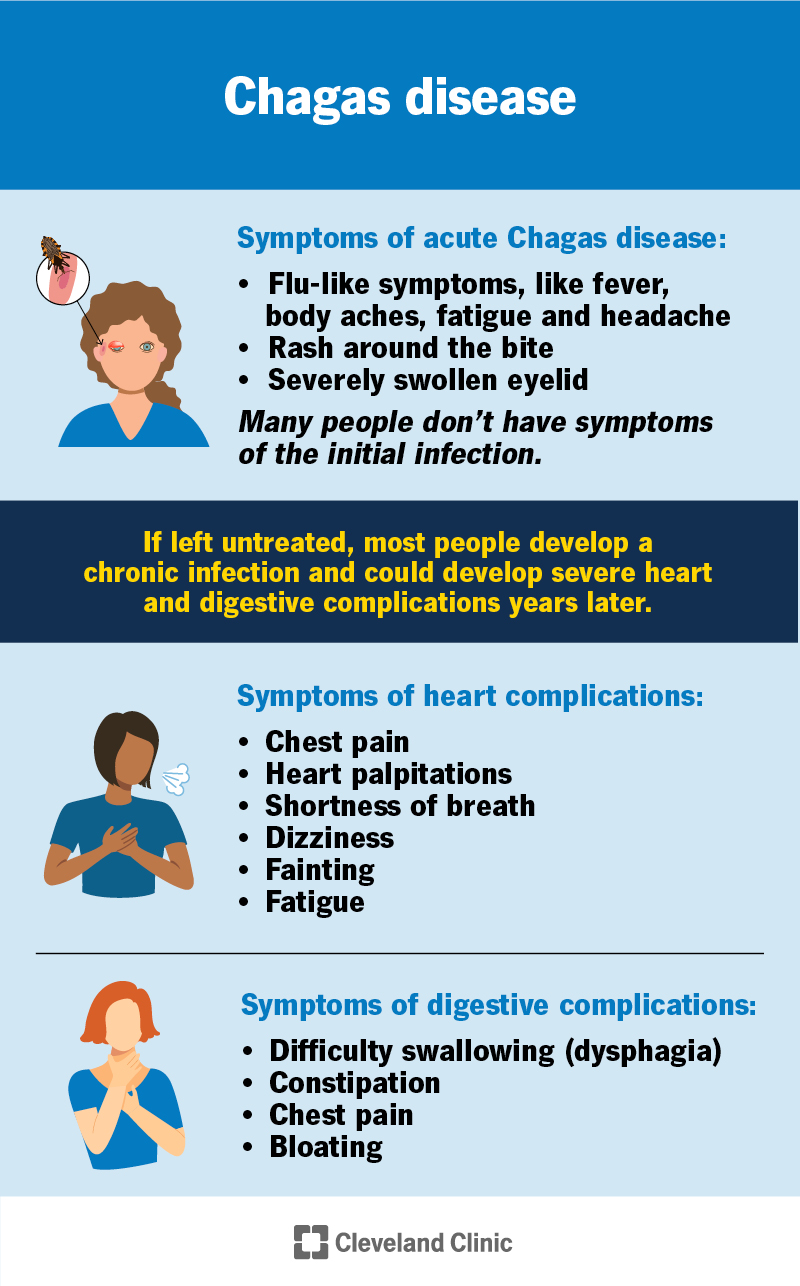Chagas disease (American trypanosomiasis) is a parasitic infection spread by triatomine bugs (“kissing bugs”). Few people have symptoms at first. But over time, parasites can move to your tissues and cause chronic infections, leading to heart and digestive tract damage. Antiparasitics can treat it, but they’re more effective in early stages.
Advertisement
Cleveland Clinic is a non-profit academic medical center. Advertising on our site helps support our mission. We do not endorse non-Cleveland Clinic products or services. Policy

Chagas disease (also called American trypanosomiasis or “kissing bug disease”) is an illness you get from an infection with the Trypanosoma cruzi parasite. Triatomine bugs (“kissing bugs”) can carry this parasite and spread it through their poop. If a kissing bug bites you, it may poop near the break in your skin, letting the parasite enter your body.
Advertisement
Cleveland Clinic is a non-profit academic medical center. Advertising on our site helps support our mission. We do not endorse non-Cleveland Clinic products or services. Policy
Chagas disease affects people throughout North, Central and South America. It’s now endemic in the United States. This means you can expect to see new cases diagnosed in the U.S. on a regular basis.
The thing about Chagas is that most people don’t know they’re infected. Many people don’t have any symptoms in the initial (acute) phase. But without treatment, most people enter a long-term (chronic) infection phase. Years or even decades later, you can develop severe complications that can affect your heart and digestive system.
Experts estimate that about 8 million people worldwide have Chagas disease — and many don’t know they have it. About 280,000 people in the U.S. have the infection.
Most people don’t have symptoms of the initial infection (acute phase). When they do, the symptoms are often mild. You may have:
Without treatment, most people go on to have a chronic infection. About 30% to 40% of people with Chagas develop serious complications. Symptoms of complications include:
Advertisement
The parasite Trypanosoma cruzi (T. cruzi) causes Chagas. Kissing bugs carry this parasite in their poop. These bugs tend to live in straw and mud. They feed off the blood of mammals, including humans, often at night when you’re sleeping. Here’s how a kissing bug bite can lead to Chagas:
In addition to kissing bug bites, Chagas can spread through:
You might be at higher risk for Chagas disease if you:
Acute Chagas disease can sometimes cause myocarditis (heart muscle inflammation) or meningoencephalitis (brain inflammation). These can be life-threatening and require immediate medical attention. These issues are more common in children or people with compromised immune systems.
Chronic Chagas disease may cause serious or life-threatening complications that affect your heart, brain and digestive tract. You may have to manage these issues for the rest of your life. Chronic Chagas complications include:
Healthcare providers diagnose a Chagas infection with a blood test. This looks for antibodies (protective proteins from your immune system) to the parasite. If you have symptoms of heart or digestive issues, you may also need additional tests, including:
Providers use antiparasitic medications to treat Chagas, including benznidazole and nifurtimox. These are most effective when used in the acute phase or early in the chronic phase.
If you have complications of chronic Chagas, you might need additional treatments. These could include surgery, anticoagulants or antiarrhythmic medications.
Advertisement
Benznidazole and nifurtimox can have unpleasant side effects that can keep people from taking them as long as they need to. These include:
If you have these side effects, tell your provider. It’s important to take your medicine exactly as prescribed to treat this condition.
Talk to your provider if you’ve lived in or visited an area where Chagas is common and:
It might help to ask your provider:
Go to the emergency room if you have symptoms of severe illness, including:
If you treat Chagas early, you have a better chance of getting rid of the parasites before they can cause serious complications. You’ll need to take medications for a month or more.
Antiparasitics may be less effective at curing chronic infections, but they might reduce your risk of severe complications. If you have a chronic infection, you and your provider will need to monitor your health closely to treat any complications as soon as possible. You may need to manage certain health issues for the rest of your life.
Advertisement
Chagas disease can lead to many different outcomes. A small number of people die from acute Chagas disease. On the other hand, a small number clear the infection without symptoms or treatment.
But most people who aren’t treated develop a chronic infection. Many can live for decades with a chronic infection without having complications. Some end up with life-threatening or long-lasting complications.
If you live in or visit areas where Chagas disease is common, you can reduce your risk by:
Consider being screened for Chagas if you’re pregnant or plan to become pregnant and you’ve been in an area where Chagas spreads.
Public health efforts — like screening donated blood, sealing living spaces and using insecticide — have reduced cases of Chagas disease. But many people might still have long-lasting illnesses and be at risk for serious complications.
If you think you could be at risk, talk to a healthcare provider about screening for Chagas disease. It can bring you peace of mind to know one way or another. If need be, a healthcare provider can help you find treatment options and look out for complications.
Advertisement
Have a virus, fungus or bacteria? Some of these “bugs” won’t go away on their own. Cleveland Clinic’s infectious disease experts are here to help.

Last reviewed on 09/25/2025.
Learn more about the Health Library and our editorial process.